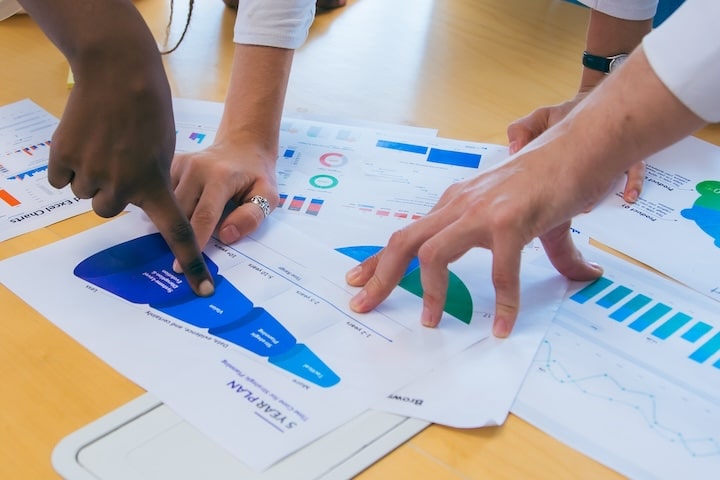For any B2B company, a well-structured sales funnel can make a huge difference when it comes to converting prospects into loyal customers. A B2B sales funnel guides potential clients through the buying process, making it easier for your sales team to manage leads effectively and in turn helping boost conversion rates and improve sales forecasting.
Sure, establishing an end-to-end B2B sales funnel will take some time and effort, but it’s well worth it—companies that define a formal sales process see an 18% boost in revenue compared to those that don’t. In this guide, we’re taking you through the steps to build an effective and high-performing sales funnel, from understanding the funnel stages to generating and nurturing leads.
Go on, get your feet wet!
Understanding the B2B Sales Funnel Stages
A successful sales funnel for B2B organizations typically consists of six stages: Awareness, Interest, Consideration, Intent, Evaluation, and Purchase. Let’s break down each stage and its purpose:
- Awareness: At this initial stage, potential customers become aware of your product or service. Your goal is to capture their attention through different marketing efforts like social media, paid ads, organic search, and content marketing.
- Interest: Once you’ve captured their attention, it’s time to pique their interest. Provide valuable content that positions you as an expert and educates them about your offerings, including thought leadership articles, ebooks, videos, and whitepapers.
- Consideration: In this stage, prospects start to seriously consider your company as a contender. They begin comparing your product with others. Here, it’s important to offer detailed information, case studies, and customer testimonials to highlight the unique benefits of your solution. Testimonial or case study videos can be especially impactful at this stage.
- Intent: Prospects show intent to purchase by engaging with your sales team or requesting a demo or trial. This is your opportunity to address their specific needs, overcome objections, and demonstrate how your product solves their problems.
- Evaluation: Here, prospects evaluate their options more closely before making a final decision. Provide personalized consultations, trials, and in-depth demos to prove your product’s value.
- Purchase: This is the final stage where the prospect becomes a customer by making a purchase. Ensure a smooth transaction process and provide excellent post-purchase support to foster long-term relationships.
Understanding these stages helps you tailor your approach at each step, increasing the likelihood of converting leads into customers.
Identifying Your Target Audience
Before you start building that funnel, you need to understand the audience you’re targeting as closely as possible. Knowing your ideal customer profile (ICP) is critical for creating a focused B2B sales funnel. An ICP—which forms the foundation of ICP marketing—is a detailed description of the type of customer that would benefit most from your product or service.
3 Steps to Create Detailed ICPs
Get started creating your ideal customer profile by following these three steps:
- Research: Conduct surveys and interviews and analyze customer data to gather insights about your audience.
- Segment: Divide your audience into segments based on common characteristics like industry, company size, needs, and job roles.
- Detail: Develop profiles for each segment, including demographic information, pain points, goals, and buying behaviors.
For example, if you sell a marketing automation tool, one of your profiles might be “Mid-Size Tech Co.,” a medium-sized B2B tech company looking for a new marketing automation solution.
Generating Leads: Awareness and Interest
Generating high-quality leads is the lifeblood of any sales funnel. This covers the stages of “awareness” and “interest.” Here are some effective strategies:
- Content Marketing: Create valuable content that addresses your audience’s pain points. Blog posts, ebooks, videos, and infographics can attract potential leads to your website.
- SEO: Optimize your website and content for search engines to increase organic traffic. Use tools like SEMrush to identify and target relevant keywords.
- Social Media: Engage with your audience on platforms like LinkedIn, X (previously Twitter), Instagram, and Facebook. Share insightful content and participate in industry discussions to build credibility and attract leads. Link back to your website so interested people can easily learn more about your offerings.
- Email Campaigns: Develop targeted email campaigns to engage leads. Use segmentation to send personalized content based on the recipient’s stage in the sales funnel.
- Webinars: Host webinars on industry-related topics to showcase your expertise and capture lead information.
Let’s look at some specific best practices for attracting high-quality leads:
- Targeted Content: Make sure your content speaks directly to your ICPs and addresses their specific needs and concerns.
- Lead Magnets: Offer valuable resources like free trials, whitepapers, quizzes, worksheets, or case studies in exchange for contact information.
- Call to Action (CTA): Include clear and compelling CTAs in your content to guide prospects to the next step.
Some of the platforms that are popular for lead generation include:
- HubSpot: A comprehensive CRM and marketing platform that helps manage and nurture leads.
- Mailchimp: Useful for creating and managing segmented email campaigns.
- LinkedIn Sales Navigator: Ideal for finding and connecting with potential B2B leads and accounts.
Nurturing Leads: Interest and Consideration

Lead nurturing is essential to move prospects through the sales funnel. This strategy overlaps with the “interest” stage and leads prospects into “consideration.” What is key here is to begin building relationships with potential customers by providing relevant information and addressing their concerns. As you convince them of your authority in the space, they’ll begin to consider your offering more seriously.
Some effective techniques for nurturing leads include:
- Personalized Email Sequences: Send a series of emails tailored to the prospect’s interests and behavior. For example, if a lead downloads an ebook on automating follow-ups, you can send related content about how to write effective follow-up emails, and then send a demo offer for your platform.
- Educational Content: Provide resources like how-to guides, webinars, and case studies that help prospects understand how your product can solve their problems.
- Targeted Follow-Ups: Use CRM and email automation tools to track lead interactions and follow up with timely and relevant information.
Qualifying Leads: Intent
Not all leads are created equal. Qualifying leads ensures that your sales team focuses on prospects most likely to convert. By the time a lead gets to the intent stage, you’ll be able to qualify them more effectively. By this point, you should have enough information about their needs and interests to score them accurately.
First, decide on your criteria for lead qualification. Two popular frameworks include:
- BANT Framework: Evaluate leads based on Budget, Authority, Need, and Timing.
- CHAMP Framework: Consider Challenges, Authority, Money, and Prioritization.
You can also consider these tools and methods for scoring and prioritizing leads:
- Lead Scoring: Assign scores to leads based on their behavior and engagement level. CRM tools can help automate this process.
- Behavioral Analysis: Analyze actions like website visits, content downloads, and email opens to gauge lead interest.
So you’ve got some qualified leads on your hands. Now it’s important to effectively transition qualified leads to the sales team. Consider:
- Clear Handoffs: Establish a smooth handoff process between marketing and sales. Use tools like Slack or a tagging system in your CRM for real-time communication.
- Detailed Information: Provide the sales team with detailed information about the lead’s interactions and interests to tailor their approach.
Now that you have some primed leads in the hands of your sales team, it’s time to start closing some deals. The more care you take in building out the final stages of your B2B sales funnel, the more likely it will be to perform well. Stay tuned for our next article on how to close out your sales funnel by optimizing the “evaluation” and “purchase” stages.
